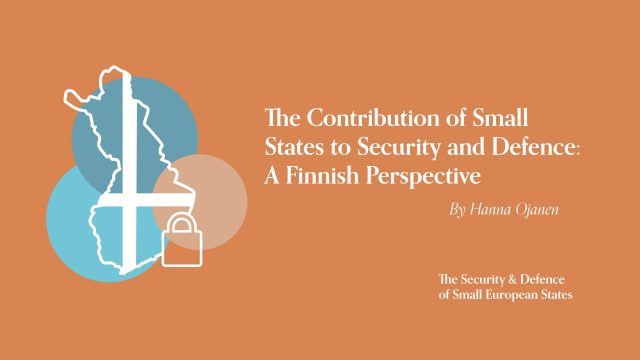Small States Contribution to Security and Defence: The Finnish Way

Author: Hanna Ojanen
Finland is no doubt seen as a net contributor to security in Europe, and certainly wants to be seen as such. It takes care of its own defence, and thereby contributes to overall security. It also takes part in cooperative endeavours enhancing security and defence in its own region and in Europe more widely.
A central tenet in this thinking is that the two are mutually strengthening: what Finland does internationally in the field of security and defence contributes to national defence capabilities.
In the past years, two major changes have taken place. First, Finnish defence is increasingly seen as linked to international cooperation. Even more: it is seen that others can, and are allowed, to contribute to Finnish security. Second, multiple forms and formats of cooperation are available.
Defence itself is changing in many ways. The importance of new domains, particularly cyber space, is increasing. The threats are often of a hybrid nature. The international situation seems more volatile and less predictable. The demands of resilience on the one hand, and high readiness and speedy reaction on the other, are growing. It is easy to say that in all these new domains, cooperation is needed. But is cooperation also becoming hybrid, and volatile in nature?
And what should one make of the return of great power politics that many see today? The centrality of great powers in security may bring with it a decreasing trust in multilateral frameworks, long-time alliances and organisations, and also in defence itself. Does it therefore necessitate a reorientation for small states that are often seen as keen multilateralists?
All this is reflected in the programme of the Finnish government that describes the European security situation as more unstable and sees threats that are multifaceted and subject to sudden, unpredictable change. It underlines the need for improved readiness. While credible national defence and stability continue to be the central goals, Finland clearly places deep international cooperation at the core of its defence capabilities. Cooperation means both providing and receiving military assistance.
This is new. Finland has been slowly warming up to cooperation in defence: it was only in 2017 that the Finnish legislation was changed to allow for the armed forces to operate abroad for purposes other than crisis management. Now, cooperation initiatives and forms are mushrooming. Various bilateral and trilateral agreements have been made in the past three years in the field of defence cooperation.
Within this cooperative framework, joint capacities building, procurement and information sharing are central. Collaboration grows both in the smaller formations led by France, the UK, and Germany, and bilaterally, notably with the UK, the US, and above all Sweden. All these are intertwined. The Finnish-US statement of intent which included joint capacity development and preparedness was complemented by a trilateral agreement with Sweden on joint planning and coordination of military exercises.
The government programme also states that Finland’s security and defence is built on safeguarding the nation’s room for manoeuvre and on keeping different options open.
What then would that room for manoeuvre look like and what then would those options be today? For small states, it may be increasingly difficult to choose where to invest, and what kind of contribution to make. It is difficult not to attempt to participate in all initiatives, just to be on the safe side. But do the various initiatives and agreements add up to a coherent whole?
We have also to take advantage of the European Union as a critical multilateral cooperation framework. In this, the recent Finnish EU presidency highlighted the opportunities. Among the presidency’s defence policy priorities were digitalisation and artificial intelligence, new technologies and new military capabilities. These were discussed in the context of the ethical framework for AI and keeping in mind European autonomy in the field. Hybrid threats were also discussed, in the framework of the EU’s mutual assistance clause in article 42.7. The informal defence ministers’ meeting in August 2019 interestingly also addressed climate change and defence.
These and other crucial issues were on the table, but the discussions again run into issues of resources and the negotiation of the next Multiannual Financial Framework. In these concrete terms the results were perhaps not what a country that wants to strengthen European defence would wish to see. For the very first time EU funds are going to be spent on defence-related purposes, and while Finnish proposals were a necessary and modest compromise, the results are modest compared to what the Commission had originally proposed, both for the European Defence Fund and for the peace fund. There is potential for much more - to deliver greater security and to contribute more effectively to national defence.
Disclaimer: The views expressed in this blog are those of the author, and not the IIEA.
